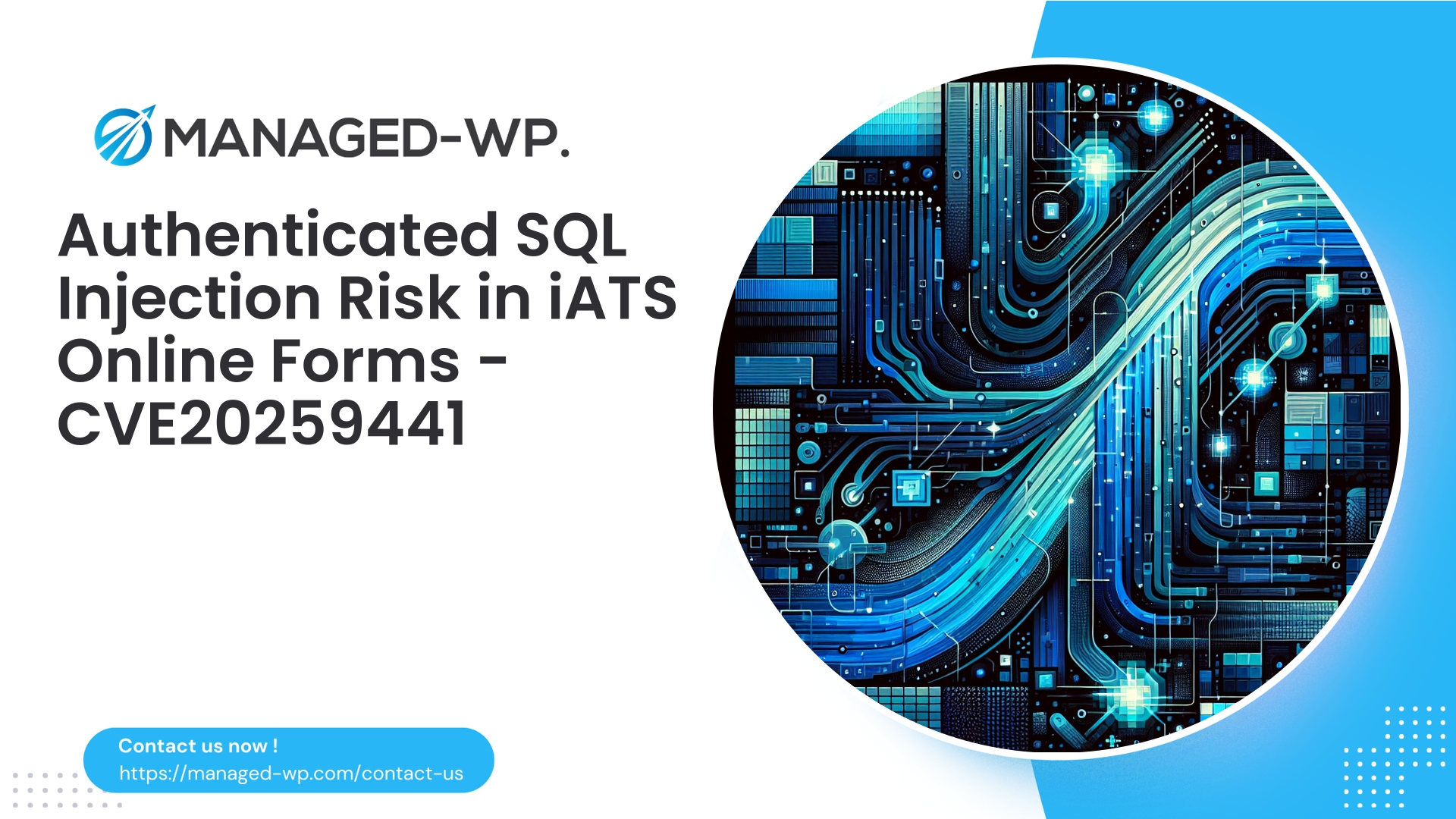| 插件名稱 | iATS線上表格 |
|---|---|
| 漏洞類型 | SQL注入 |
| CVE編號 | CVE-2025-9441 |
| 緊急 | 低的 |
| CVE 發布日期 | 2025-08-29 |
| 來源網址 | CVE-2025-9441 |
緊急公告:iATS 線上表單(≤ 1.2)— 已認證貢獻者 SQL 注入漏洞 (CVE-2025-9441) — WordPress 網站經營者必備指南
作者: 託管 WordPress 安全團隊
日期: 2025-08-29
標籤: WordPress、安全性、SQL注入、WAF、外掛漏洞
概述: 編號為 CVE-2025-9441 的嚴重安全漏洞會影響 iATS Online Forms 外掛程式的 1.2 及更早版本。該漏洞允許具有「貢獻者」角色的已認證用戶利用未經清理的資料進行攻擊。
命令此參數會導致 SQL 注入漏洞。這份由值得信賴的美國 WordPress 安全專家 Managed-WP 提供的全面簡報詳細介紹了漏洞的運作機制、風險影響、偵測指標和可行的緩解策略。
目錄
- 事件概要
- 對 WordPress 網站利害關係人的重要性
- SQL注入向量的技術分析
- 開發條件和影響評估
- 入侵指標和日誌審查指南
- 立即採取的補救措施(24小時內)
- 短期緩解措施(1-7天)
- 建議的安全編碼和長期修復方案
- WordPress WAF 的角色和規則建議
- 事件回應規程
- Managed-WP 如今如何提供保護
- 閉幕致詞和負責任的披露
事件概要
Managed-WP 安全研究人員發現 iATS Online Forms 外掛程式 1.2 及更低版本有 SQL 注入漏洞。此漏洞源自於 SQL 注入的驗證不足。 命令 貢獻者層級的使用者在與排序或清單顯示功能互動時可以操作此參數。這種未經處理的輸入會直接嵌入資料庫查詢中,可能導致惡意 SQL 命令的執行。
儘管緊急程度評級為“低”,但此漏洞仍然十分嚴重,因為 SQL 注入風險包括未經授權的資料提取、資料庫篡改以及潛在的網站入侵。利用此漏洞的複雜程度取決於特定環境,但即使是盲注 SQL 注入也可能造成重大損失。
對 WordPress 網站利害關係人的重要性
- 貢獻者角色通常會被指派給社群成員或特邀作者,而這些人可能並非完全值得信任。這種漏洞會增加允許此類用戶使用的網站的風險。
- 攻擊者無需管理員權限即可利用此漏洞,從而大規模擴大了攻擊面。
- WordPress 資料庫包含高度敏感的訊息,包括使用者憑證和元數據,攻擊者可以透過 SQL 注入讀取或修改這些資訊。
- 官方修補程式可能不會立即發布;主動緩解措施,包括存取控制和 WAF 規則部署,至關重要。
SQL注入向量的技術分析
此漏洞源自於在動態 SQL 查詢建置過程中對使用者提供的資料處理不當。安全實務要求採取以下措施之一:
- 使用帶有參數的查詢和預處理語句來安全地綁定變量,或者
- 驗證並列入白名單輸入參數,以防止注入惡意負載。
常見的實施錯誤包括合併原始數據 命令 參數值直接插入 ORDER BY SQL 子句,未經清理,允許注入任意 SQL 語法。
- ORDER BY 子句接受列名和方向關鍵字(ASC/DESC)。插入類似這樣的字符
;,--或者,可以使用 SQL 關鍵字(SELECT、UNION)來操作查詢邏輯。 - 即使沒有回傳完整的查詢結果,攻擊者也可能利用盲注 SQL 注入技術逐步提取敏感資料。
- 某些託管環境可能會限制多語句查詢,但盲目攻擊技術仍然是一個嚴重的威脅。
在 iATS 線上表單外掛中, 命令 此參數對貢獻者使用者可用,從而暴露了一個嚴重的攻擊面。
開發條件和影響評估
利用的前提條件:
- 插件必須處於啟動狀態,且版本為 1.2 或更早。
- 攻擊者需要 WordPress 貢獻者等級的憑證。
- 貢獻者操作(例如管理員清單或 AJAX 端點)可存取的易受攻擊程式碼路徑。
潛在影響:
- 洩漏敏感表格,包括使用者帳戶和插件資料。
- 有機會取得密碼雜湊值、會話令牌或 API 金鑰,用於離線破解或橫向移動。
- 透過修改資料庫提升使用者權限,從而提升使用者角色。
- 透過資料庫後門或配置變更實現持久化,可能導致遠端程式碼執行。
- 資料損壞或遺失導致網站不穩定。
資料庫限製或輸出編碼等緩解因素可能會降低影響,但不能消除風險。
入侵指標和日誌審查指南
安保團隊應注意以下跡象:
- Web伺服器日誌: 異常
命令參數值包含可疑的 SQL 令牌,來自同一 IP 的重複管理端點存取。 - WordPress審核日誌: 未經授權的角色變更、新增管理員使用者、外掛程式設定意外修改。
- 資料庫日誌: 與貢獻者帳戶相關的 SQL 錯誤或長時間執行的查詢。
- WAF警報: 觸發與 SQL 注入模式偵測相關的規則。
- 檔案系統監控: 在未進行合法更新的情況下,建立或修改外掛程式或主題目錄中的 PHP 檔案。
在調查過程中,透過將日誌儲存為唯讀狀態來維護完整性。
立即採取的補救措施(24小時內)
- 限制貢獻者帳號: 暫時降低或停用非必要的貢獻者帳戶,並審查信任等級。
- 停用插件: 如果可能,請停用 iATS 線上表單,直到有安全性更新可用;如果是關鍵任務,請謹慎進行並採取緩解措施。
- 部署 WAF 規則: 阻止或消毒
命令用於防止注入 SQL 元字元和意外值的參數。 - 審計行政活動: 檢查與「貢獻者」相關的異常管理員建立或角色變更。
- 建立備份: 在進行任何更改之前,請對網站檔案和資料庫進行全面的離線備份。
短期緩解措施(1-7天)
- 伺服器級過濾: 配置 ModSecurity 或同等過濾系統以拒絕可疑載荷。
- 白名單排序值: 使用配置或修補程式將排序參數限制為已知的安全性列名和方向。
- 增強角色管理: 對具有較高權限的使用者實施嚴格的角色強制執行,並要求進行多因素身份驗證。
- 持續監測: 建立異常活動偵測警報,例如異常資料庫錯誤或頻繁的參數異常。
- 與插件供應商協調: 密切注意官方補丁,並在安全環境中驗證後再部署。
建議的安全編碼和長期修復方案
開發人員應透過實施以下措施來解決根本原因:
- 嚴格限制 ORDER BY 輸入項目的白名單:
- 使用已準備好的報表: 切勿將原始使用者資料直接插入 SQL 查詢;必須正確綁定所有值。
- 對輸入進行清理和標準化: 根據需要強制執行資料類型、長度限制和正規表示式模式。
- 正確使用 WPDB 抽象層: 負責任地使用 WordPress 資料庫 API,以防止注入攻擊。
- 擴大測試覆蓋範圍: 整合單元測試和模糊測試,重點在於排序和參數處理。
- 應用最小權限原則: 使用權限僅限於網站運作所需最小權限的資料庫帳戶。
$allowed_columns = ['created_at', 'name', 'id', 'date']; $column = in_array($requested_column, $allowed_columns, true) ? $requested_column : 'id'id. strtoupper($requested_direction) === 'DESC' ? 'DESC' : 'ASC'; $query = $wpdb->prepare("SELECT * FROM {$wpdb->prefix}mytable ORDER BY $column );
WordPress WAF 的角色和規則建議
在修補程式發布之前,Web應用程式防火牆對於降低風險至關重要:
- 參數強制執行: 堵塞
命令輸入包含 SQL 元字符,並強制執行白名單字符集。 - 白名單強制執行: 強制只允許使用已識別的列名和排序方向。
- 特徵檢測: 識別典型的 SQL 注入模式,例如 UNION 或基於時間的有效載荷。
- 異常檢測和速率限制: 限制來自單一 IP 位址的濫用請求,以免影響管理端點。
- 日誌記錄和警報: 記錄並通知安全人員 WAF 觸發的封鎖情況。
- 情境感知: 提高已認證使用者執行意外操作的警報閾值。
重要的: 在非生產環境中仔細測試 WAF 規則,以避免干擾合法功能。
事件回應規程
- 隔離: 隔離受影響的系統或限制訪問,以防止進一步損害。
- 保存證據: 以唯讀方式收集和保護日誌、資料庫快照和相關文件。
- 確認範圍: 識別被盜用的帳戶以及資料庫和配置中的可疑變更。
- 包含: 停用存在漏洞的外掛功能,並輪換所有管理員和特權使用者的憑證。
- 乾淨的: 清除惡意變更並對照可信任備份驗證檔案完整性。
- 恢復: 從可信任備份中恢復,並執行全面的惡意軟體掃描和程式碼審查。
- 報告與學習: 通知相關利害關係人,並根據吸取的經驗教訓更新安全協議。
Managed-WP 如今如何提供保護
Managed-WP 提供強大的安全解決方案,旨在緩解諸如 CVE-2025-9441 之類的漏洞:
- 自動虛擬補丁阻止惡意行為
命令參數有效載荷用於防止 SQL 注入攻擊。 - 持續監控,偵測攻擊企圖和可疑的使用者角色修改。
- 分層管理的 WAF 結合基於行為的偵測,可在插件開發者發布修復程式時降低風險。
如果您尚未啟用 Managed-WP,我們的免費方案可為您提供即時的基本保護:
立即開始使用 Managed-WP 免費計劃
免費使用專為 WordPress 設計的託管防火牆保護和惡意軟體掃描器:
https://my.wp-firewall.com/buy/wp-firewall-free-plan/
計劃要點:
– 免費:託管防火牆、無限頻寬、核心 WAF、惡意軟體掃描和 OWASP Top 10 緩解措施。
– 標準版($50/年):增加自動惡意軟體清除和 IP 管理功能。
– 專業版($299/年):包含每月安全報告、虛擬修補程式和進階支援。
選擇適合您環境的保護級別,立即開始保護您的 WordPress 網站。
閉幕致詞和負責任的披露
SQL注入漏洞仍然是網路安全領域的頂級威脅,因為它極有可能破壞資料和網站完整性。 CVE-2025-9441漏洞凸顯了嚴格驗證的必要性,尤其是在授予低權限角色(例如「貢獻者」)資料庫存取權限的情況下。
建議網站經營人員立即採取以下措施:
- 存貨: 驗證 iATS 線上表單外掛程式是否存在以及版本。
- 包含: 如果無法及時修復,則限制貢獻者權限或停用外掛程式。
- 保護: 啟用 WAF 安全措施,例如 Managed-WP 中的通用參數白名單和行為控制。
- 監視器: 認真審核網站日誌、使用者角色和資料庫活動。
我們鼓勵開發者採用上述安全編碼實務。網站所有者應謹慎對待所有貢獻者帳戶,並限制其存取權限。
如需專家協助評估網站風險或實施緩解策略,Managed-WP 的安全團隊隨時為您提供支援。透過我們的免費計劃,即可獲得即時保護和專家指導:
https://my.wp-firewall.com/buy/wp-firewall-free-plan/
保持警惕。優先考慮驗證、白名單和最小權限原則—這是抵禦注入式攻擊的最佳防禦措施。
如有需要,Managed-WP 可以提供一份針對您的環境量身定制的簡潔補救清單,或協助驗證您的防火牆規則是否有效緩解 CVE-2025-9441 攻擊向量。



















